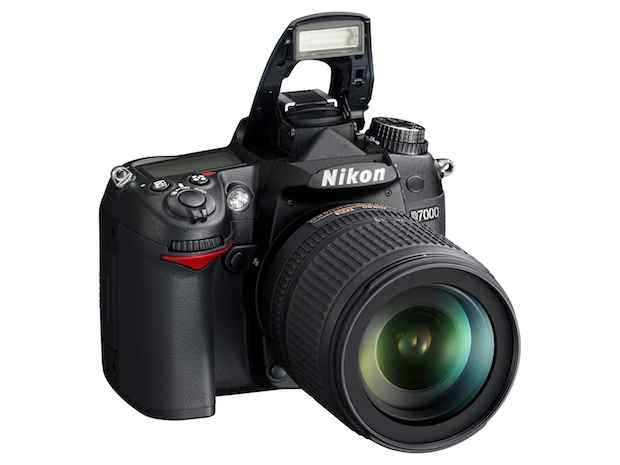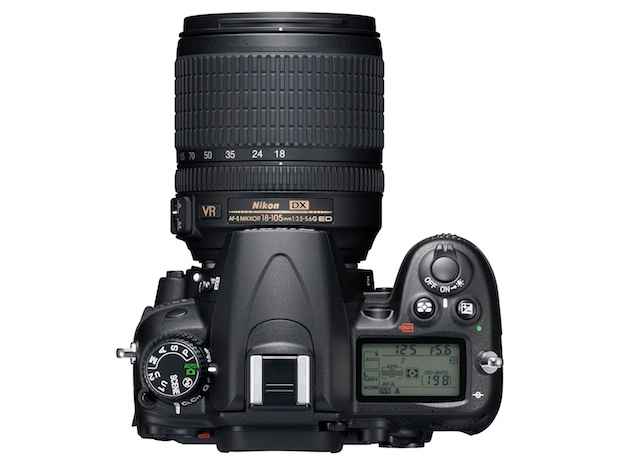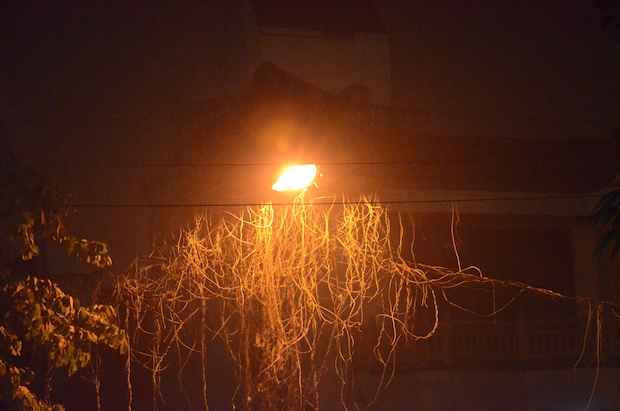Nikon D7000 - An interesting middleman detailed review
For Nikon fans, the D7000 has been an agonising wait. Even those looking to buy their first enthusiast-grade dSLR, or even people upgrading from their D60's and D3000's. A few Canon users would also have been curious. And while Nikon launched the D7000 around three months back, review samples were scarce, or so we had been told. The release was inevitable, given the D90's age. What we were curious to see, is whether the D7000 would be a gentle refresh, or would it be more of an evolution. The pricing was another factor. The D90 debuted at above Rs. 90,000 with kit lens, and now goes for as little as Rs. 50,000.
But calendars and product cycles apart, the D7000 was more needed by Nikon than desired by us. For while the D90 was toe-to-toe with the Canon EOS 50D, the EOS 7D killed it. While the 7D sells for 80,000 body only, for many, the brand new sensor, excellent ergonomics and focussing system and great high ISO performance was all the justification needed to shell out more dough. Then the veritable 7D sensor spawned the EOS 60D and the EOS 550D - more thorns in Nikons side. Given that Sony just released a 16.2-megapixel sensor with their A55 dSLR, it was only a matter of time before a customised version was delivered to Nikon's doorstep.

Up front, let's make one thing clear as crystal - the D7000 betters the D90 in every way. In fact, a lot of the D7000 is dereived from the veritable D300s, and it has a few features that the D300s misses. Although the body size and heft is similar to the D90, ditto the ergonomics and button placement. But then, the D90 was a tried and applauded design, and we see no reason to tamper with a winning formula. Throughout this review, I've compared the D7000 to the Nikon D90, Nikon D300s and Canon EOS 7D.
Look and feel
Though the dimensions are similar, the D7000 feels much better. While your fingers can't tell you, but this is actually true for partial magnesium-alloy substitutes, what was totally a polycarbonate shell. The rubber grip on the D7000 is a letdown - it is the same as on the D90 and still feels like too hard. This coming from someone who has handled luxurious, soft and substantial rubber grip son on the Nikon D300s and Canon EOS 7D. Given the price difference between the D90, we feel Nikon could given a better grip. However, the camera feels solid, definitely more so than the D90.
The status LCD is also the same size as the D90, and smaller by a good bit than the ones on the larger Nikon bodies, like the D300s. While the dual SD card bay door opens with a reassuring spring action, the battery door feels limp, unlike the nice spring loaded door on the EOS 7D. The lines on the D7000 are tight, with no gaps. The flaps are rubberised but it's a hard sort of rubber, and would not be weather sealed. Comparatively, the flaps on the D300s are softer and seal better.
[RELATED_ARTICLE]Owing to a smaller footprint, and lower profile, the grip of the D7000 is less comfortable, as the camera fits in hand, with room to spare. The D300s has a substantial feel, and your fingers get more camera to grip. Ladies will find the D7000 better. Thumb positioning on the D7000 is cramped, comparatively, the EOS 7D and D300s are a joy to hold. Owing to the smaller size and depth, some of the buttons on the rear of the body are smaller, and have noticeably less travel. For example, the joypad is very clicky, and quite frankly feels cheap. The buttons on the left side of the LCD are smaller and marginally less usable than the ones on the D300s, but slightly larger than the ones on the D90. They're usable with gloves too, but certainly not the best around for that purpose.
Controls, layout and intuitiveness
The metering selector ring on the D300/D300s is absent, modifying this setting now involves pressing a dedicated button and using the rear dial - this is less convenient than the layout on the larger Nikon bodies, but then, given the reduction in body size, we suppose some functions had to be remapped. The focus mode switch has manual and auto options. There is no switch for setting the autofocus area, like the D300s has, and while this option can be changed from within the menu, doing so is much more tedious. The tried and tested front and rear dial control system is intuitive to use, and to be honest, just as ergonomic as the rear and top dial on the EOS 7D and other Canon dSLR's. Which system you prefer, is largely preferential, although from our experience, Canon's rear dial wears better, and owing to a larger surface area, is a little more convenient to spin, Nikon's requires a slight repositioning of grip.
On the rear, the buttons are well laid out, and placed, similar to the layout on the D90. A flip switch for toggling video/still mode is a major change, highlighting the fact that the Nikon D7000 is a much more serious video recorder than any previous Nikon dSLR. Nikon still relies on a plastic screen protector, unlike the EOS 7D that features a scratch-resistant glass cover on their LCD, Nikon seems to use a transparent polycarbonate material. Coming back to the joypad, the centre button of which now features the OK function. Although all larger Nikon dSLR bodies share this function, the D7000 misses a dedicated OK button that is normally right at the bottom of the column of buttons on the left side of the display. This is not very important, because on the D300s (for example), both OK buttons correspond to a thumb, meaning either location is ergonomic.

The status LCD on the top, is smaller than the one on the D300s, and is not as informative. There are now two dials on the left top, on set atop the other. The drive mode dial is lockable and located beneath the mode dial. The dial lock is now on the back, and in easy reach of your left thumb. On the D300s, this lock was on the front portion, meaning you had to adjust your grip, in order to use your index finger to press the lock, thereby releasing the dial. We feel the system on the D7000 is more ergonomic and usable. The mode dial has no lock, but a nice positive ratchet mechanism when spun. However, there is a slight chance that it could brush against clothes and move, thereby changing the shooting mode, and possibly ruining the next shot.
There are no dedicated ISO and white balance buttons, and these functions have been mapped to the buttons on the left of the LCD. This could actually be better than the layout on the D300s, since these buttons are closer and hence quicker to access. However, one cannot help but compare the press-button-and-spin-dial set up to Canons infinitely cleaner press-leave-and-spin. With Nikon, you need to keep the corresponding button pressed while spinning the dial, while with Canon, pressing the button selects that option for five seconds, giving you ample time to spin the dial without bothering about keeping a button pressed. Obviously, those used to the Nikon system will disagree, but in A to B comparisons, the Canon system seems superior.
Overall, the D7000 comes across as a serious dSLR body, with good ergonomics, and a good control system. It all depends on what you're used to. If this is your first dSLR, it will quickly grow on you, even though the menus are long and detailed, this is the price you pay for a lot of manual control, and the ability to tweak just about any component. If you are migrating from a Nikon D90 or a D60/D3000, the menu system will seem simple, and the additonal wealth of buttons will certainly be handy. Coming from a D300s, you will probably miss a couple of dedicated control buttons, while appreciating a couple of thoughtful tweaks, but overall, the D300s is the more ergonomic body of the two. Coming from a Canon system, you will probably miss a few controls and take awhile to memorise the new layout and corresponding functions. Personally, I still feel the EOS 7D was quicker to learn, and quicker to use than the D7000, comparing the first week I spent with the 7D (from memory), and the first week with the D7000. The fact that the 7D is a larger camera also helps, for buttons are more spaced out as well.
The viewfinder on the D7000 is pretty good - it's bright, and better than the one on the D90. However, the 7D has a brighter viewfinder. Both cameras offer 100 per cent frame coverage, making them fairly exclusive. The D7000 features two SD card slots. This is a plus for many and the two slots can be setup in a number of ways. One card slot can be used as a buffer when the other fills up, RAW and JPEG images can be stored to individual card slots, or the second slot can act as a backup. The 7D has a single slot, while the D300s has one CF and one SD slot. With SD memory becoming cheaper, and the buffer system of the D7000 not as robust as the one on the D300s, we figure Nikon chose SD over CF for its universal appeal and price.
Click next for Performance and our final take
Performance: Focussing
The new focus system is something that has been talked about a lot. Designated as the Multicam 4800DX, the focus system consists of 39 points, out of which 9 points are cross-type. This system is a radical step forward from the D90 that had an 11-point autofocus system. However, it's inferior to the 51-point system on the D300s, out of which 15 points are cross-type. The EOS 7D (review here)also has a better autofocus system with 19 points, all of which are cross type. Just like other Nikon dSLRs, the points are overlaid via an LCD and not etched on the viewfinder.

The D7000 does exceptionally well in low-light, and is arguably the best crop dSLR for shooting at higher ISOs. Settings: ISO 10,000 (yes! 10,000); shutter speed: 1/30; Aperture: f7.1; focal length: 80mm
On to practical aspects. The focus point array occupies a good area of the screen, though marginally smaller than the D300s that offers excellent coverage. Canon, with their sparser focus points would argue the point stating that older film SLR's had a single focus point at the centre. Regardless, the D7000 does not focus as fast as the D300s. The 7D too, is faster, and uncannily accurate. In fact, in this regard, the 7D is better than the D7000 - it focusses more faster, and tends to focus on the intended subject more often. It also seems to catch moving objects better. However, in terms of focussing accuracy, it's a draw.
Focussing with the D7000 is largely lens dependent, and the 18-105 lens used most is not speedy. The 50mm f1.8 is a bit faster, but we figure the USM motor lenses will be faster still, and the 50mm f1.8 is noisy and unrefined to go with its throwaway price. Focus accuracy is spot on, even in very low light, though it gets slower. In low light, the D7000 seems to focus reasonably well, and is a hairsbreadth behind the D300s. Comparisons with the EOS 7D are a little unfair, because while the Canon was faster, it could be the excellent Canon 15-85 IS USM lens is playing a role. Nevertheless, all three dSLRs focus pretty fast in dim light, and are lightning fast in reasonably well lit scenarios.
Performance: Image quality
If you've spent sleepless nights worrying about the image quality of the D7000 - lay your fears to rest. On the whole, image quality is excellent. The output from the D7000 is punchy, without being too vivid, and colours are neutral. At ISO 100 up to 400, you are in for a treat - the output of the D7000 is pretty much in line with the EOS 7D and D300s, and if you are looking at screen-size images, the differences are impossible to spot. More importantly, the D7000 manages to retain more detail and has a better dynamic range than the D90.

Here's a 100 per cent crop. While there is some noise present, it's more natural looking, like film grain, and less like artifacting. This is slightly better than the output from the Canon EOS 7D, and way better than the output from the Nikon D300s. Settings: ISO 1600; Exposure: 1/30 sec; focal length: 90mm; Aperture: f7.1
[RELATED_ARTICLE]On to high ISO performance. There has been a lot of talk about the low-light performance of the D7000, and to be honest, we feel it lives up to the hype. Comparatively, The D300s produces more noise even at ISO 1600. In fact, the D7000 produces better images at ISO 3200 than the D300s does at ISO 1600, using identical settings, and of course, the same lens. This is heady stuff - for the sensor rating has grown to a respectable 16.2-megapixels, from 12.1-megapixels. In the same way, the EOS 7D noses ahead of the D300s - this is pretty remarkable, given a 50 per cent hike in megapixel count, and a marginally smaller sensor. The D7000 gives the 7D a healthy run for its money, and we feel the D7000 is identical or a bit worse, at ISO 1600. At ISO 3200, things change for the better for Nikon, and the D7000 enjoys a marginal lead over the 7D. This lead grows at ISO 6400, but really, we're talking about sensors that are a generation apart chronologically. If you're talking about high ISO, low-light performance, the D7000 is probably the king among crop sensors, with the 7D having a small lead at ISO 1600. Check out the low light performance of the EOS 7D here.

Good clean output, detailed, but a slight lack of highlighting. Settings: ISO 100; shutter speed: 1/50 sec; Aperture: f3.6; focal length: 18mm
Additionally, the D7000 supports really high ISO settings, and even at ISO 10,000, the image is usable with web size prints being very acceptable. On the 7D too, this is the case, and for web images, either of these cameras will suffice. At ISO 6400 and above, the D300s exhibits visible noise, even in smaller-sized images.
Our take
With the D7000, Nikon has pulled all stops delivering something for the semi-professional. Although it is not an immediate D90 replacement (given the price difference), there is sufficient justification for even D90 owners to upgrade, not the least of which is a two-stop advantage, (at least), in low-light. Also remember, given a 4-megapixel advantage going to the newcomer, this difference in performance is a pretty big deal. D300s owners will probably await a D400, or jump into the world of full frame dSLRs, for while the D7000 offers better low-light performance, the button layout is not as good, and neither is it as well built. D60/D90 users will find migration easy on account of similar ergonomics, D300/D300s users will not. However, the D7000 is still a good distance away from the intuitive Canon EOS 7D control layout, and at times, the body feels insubstantial in-hand. Build quality is good for its price bracket, but not so good considering the next tier of dSLRs.
In terms of performance, the D7000 is very good, particularly in low-light, and if a lot of your shooting happens late in the day, the D7000 is an easy recommendation. We also recommend the D7000 to those looking to buy an enthusiast cum semi-pro body. However, given the MRP, we feel this camera is a little expensive. 7D users should not even bother looking here, as other than low light performance, where the D7000 is better, the 7D leads in practically all other departments. D300s owners could consider the image quality an upgrade, but not the ergonomics and build quality. Additionally, we'll likely see pro-grade bodies with newer sensors in the third quarter of 2011 from both manufacturers - so you might want to postpone your purchase.
Another point worth mentioning is the 18-105 kit lens doesn't cut it. We recommend some top quality glass, for with the bump in resolution, the sensor is now being held back by the glass used. The Nikkor 16-85 lens would be a nice, albeit expensive compliment.
Specifications: Sensor: 16.2-megapixels; sensor size: 23.1 x 15.4mm; autofocus: 39 point, 9 cross-type; memory interface: dual SD slots; weight: 780 grams
Rating:
Features: 8
Performance: 7
Build: 7
Value: 7
Overall: 7
| Brand | Nikon |
| Model | D7000 |
| Price (Rupees) | 74,450 (Body) |
| Specifications | |
| Sensor resolution (Megapixels) | 16.2 |
| Sensor size (mm) | 23.1 x 15.4 |
| Sensor type | CMOS |
| Viewfinder type | Optical Pentaprism |
| ISO (low) | 100 |
| ISO (high) | 6400 (25600 with boost) |
| Shutter speed (fastest) | 1/8000 seconds |
| Shutter speed (slowest) | 30 seconds |
| Auto Focus system | 39 point, 9 cross type |
| Manual Focus (Y/N) | Y |
| Macro focus range | |
| White balance override | 12 positions plus manual |
| Aperture range | - |
| Built-in Flash (Y/N) | Y |
| Flash range (in meters) | 12 |
| External flash | Yes, Hot-shoe |
| Exposure compensation range | -5 to 5 EV in 1/3 EV steps |
| Metering | Multi, Center-Weighted, Average, |
| Aperture priority (Y/N) | Y |
| Shutter priority (Y/N) | Y |
| Continuous Drive (frames per second) | 6 |
| Attached / kit lens zoom | 18-105 (5.8x) |
| LCD size | 3.0-inch |
| LCD Resolution (dots) | 9,20,000 |
| Image formats supported | RAW, JPEG |
| Microphone type | Mono |
| HDMI out | Y |
| Max Video capture resolution | 1920 x 1080 (1080p) |
| Battery Type (AA, Li-ion etc) | Li-ion |
| Battery Capacity (mAH) | 1900 mAh |
| Memory cards used | Dual SD (SDXC supported) |
| Body dimensions (in mm) | 132 x 105 x 77 |
| Weight (in grams) | 780 (body) |
| Build Quality (So 10) | |
| Body | 7.25 |
| Lens (or kit lens) | 6 |
| Buttons and dials | 7.75 |
| Bays | 6.75 |
| Screen | 7 |
| Performance | |
| Focussing accuracy (wide angle) | 8 |
| Focussing accuracy (long end) | 7.25 |
| Quality (dynamic range, highlighting) | 8.25 |
| Quality (sharpness, micro-detail) | 8 |
| High ISO tests (So 10) | |
| ISO 800 | 8 |
| ISO 1600 | 7.75 |
| ISO 3200 | 7.75 |
| ISO 6400 | 7.5 |
| Flash test (portrait) | 7.5 |
| Flash test (fill-scene) | 7.5 |
| Video Quality (720p) | 7.25 |
| Video Quality (1080p) | 7.25 |
| Ergonomics (So 10) | |
| Ease of use and intuitiveness | 7.5 |
| Buttons and dials | 7 |
| Interface and menus | 8.5 |
Contact: Nikon India Pvt. Ltd.
Phone: 1800-102-7346
Website: www.nikon.co.in
Email: nindsales@nikonoa.net
Price: Rs. 89,950 (MRP, with 18-105 kit), Rs. 74,450 (MRP, body only)
[ad_2]
Source link

Post a Comment